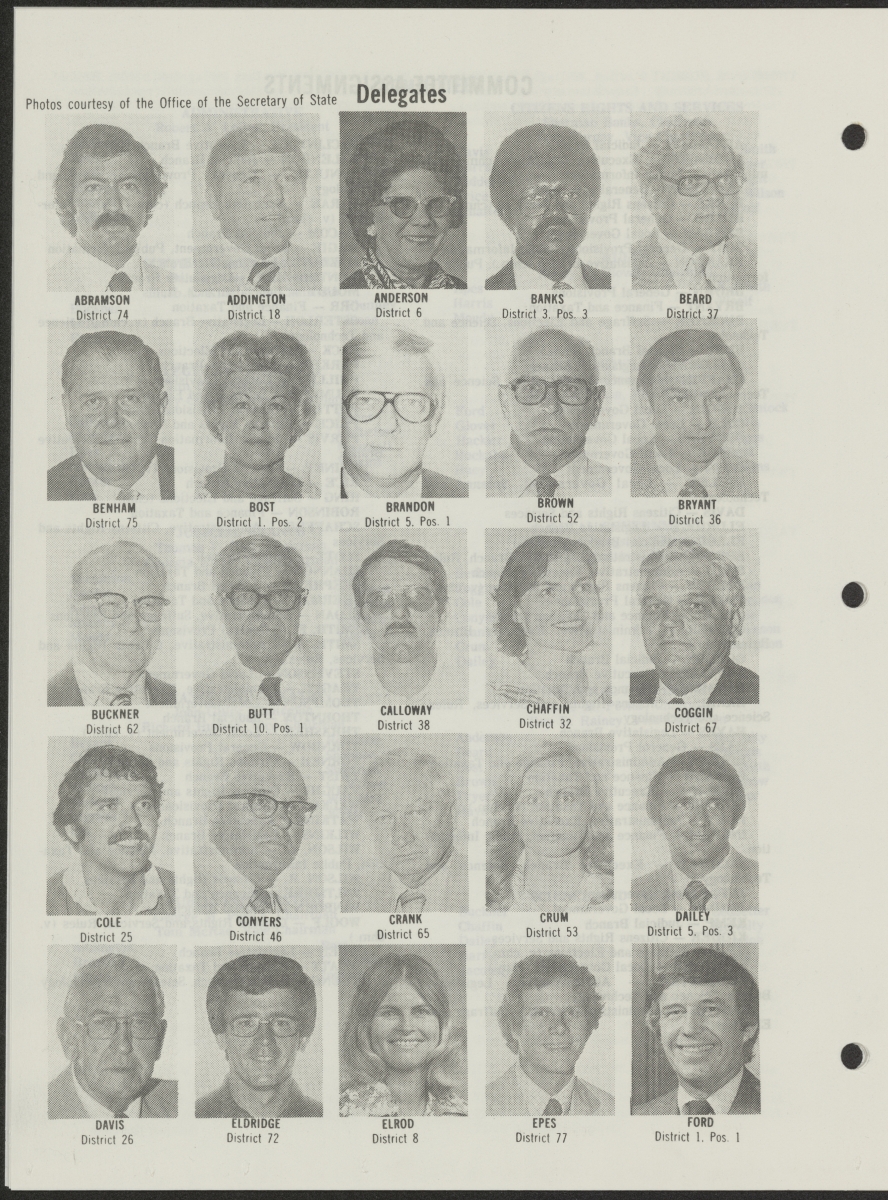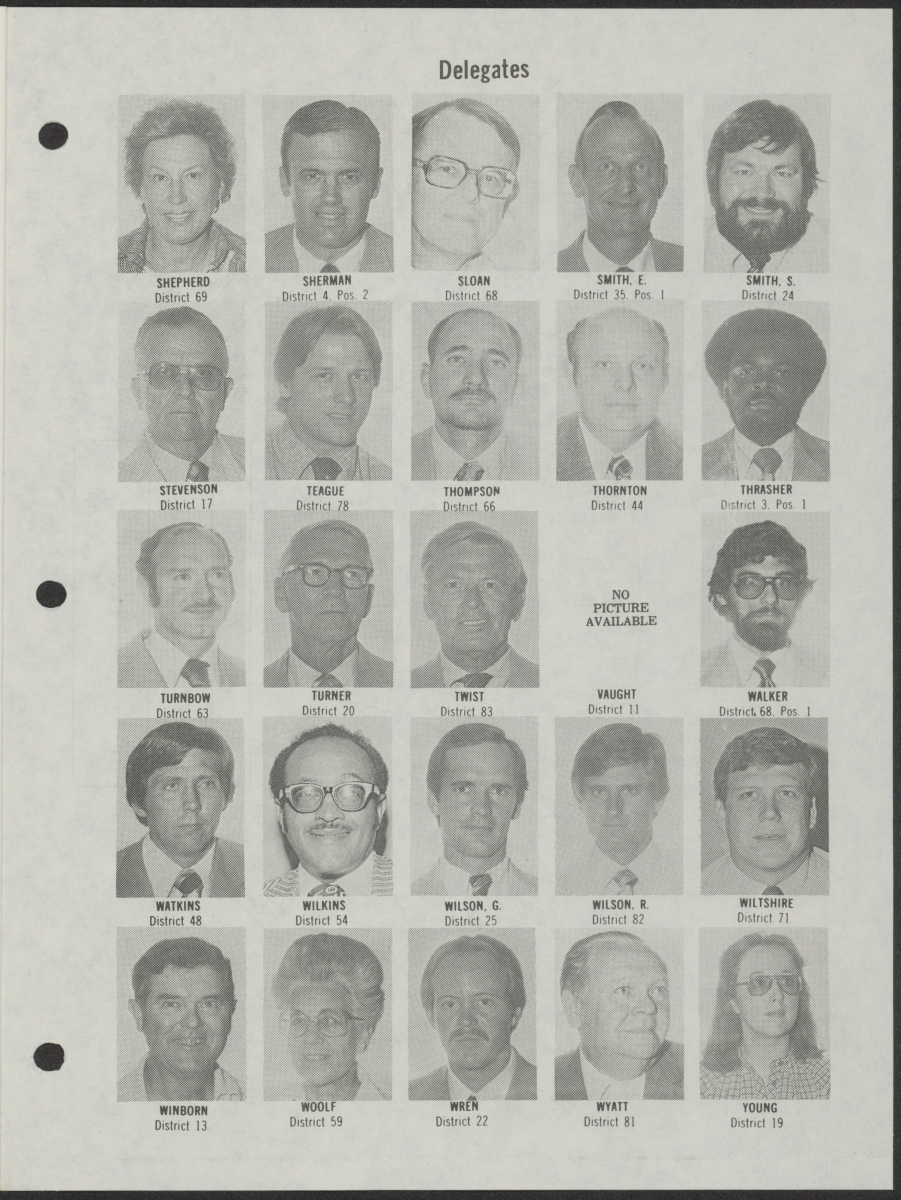Convention Delegates
By Ethan Fercho
The Arkansas Constitutional Convention of 1979-1980 was a momentous event which caught the attention of many people from business owners, lawyers, politicians, and regular citizens. Despite not being widely known, the Convention had an impressive roster of people from a variety of different career paths, upbringings, and ages.
The 1979-1980 Convention was unique in that the delegates were not appointed as had been done in the past, but elected by the people. During this time, some government positions such as the mayor of Little Rock were appointed, meaning they were selected by other government officials. However, the delegates for the Convention were elected by local Arkansans. The election process for these delegates resembled that of a House of Representatives election today; officials divided the state into specific districts with roughly equal population sizes, then the residents of those districts voted for a delegate to represent them at the Convention. In total, the Convention employed one hundred delegates to serve in the general assembly and on specific committees.
Since Arkansas’s political leaders called for the Constitutional Convention as a way to affect change and benefit the state as a whole, they did not try to unduly restrict access to running for the delegate positions. In fact, they encouraged people of all backgrounds to run.
As a result, the make-up of the delegates was very diverse. They had a range of professions including teachers, businessmen, farmers, and lawyers. Ministers and businessmen also made up a substantial portion of the delegates. Even within the group of professional lawyers, many still had part-time engagements in agriculture or other work. Virtually every member identified themselves as being some form of Christian; however, one delegate identified as Jewish, and a handful of others did not specify. Some delegates were quite young, being in their late twenties or early thirties. While the older and more experienced members usually held the leadership positions on the committees and performed other staff roles, no specific age group had a significant majority at the Convention. In contrast, Caucasian men dominated the make-up of the delegates, but four African Americans and thirteen women also served. However, since race was not officially listed in the profiles of the delegates, it is quite possible that many of the delegates may have identified with other non-Caucasian groups such as Native Americans.
Attendees
100 Delegates
Age Range
21 to 77 Years Old
Gender
87 Men
13 Women
Race
96 Caucasian
4 African American
Religion
94 Christian
1 Jewish
5 Unspecified
Among the one hundred delegates at the Convention, several stood out as leaders or were more outspoken and vocal for certain issues. Robert Leflar, a veteran of service in the Arkansas government, served as the president of the Convention. There were several other members that were veterans of the Arkansas political system or had also served during the 1970 Convention, such as Cal Ledbetter, Bobby Glover, and Henry Wilkins. Other delegates were relatively new to Arkansan politics but would continue their careers and serve in a variety of roles. For instance, Jim Dailey would serve as mayor of Little Rock in the 1990s and 2000s and as state tourism director in the 2010s. Henry Wilkins, William Thrasher, B.J. Harris, and Sherman Banks were the four African American delegates, and Thrasher was particularly outspoken on debates related to civil rights. Despite the relatively small number of female delegates, the majority actively participated in the debates and made substantive contributions, perhaps disproportionate to their small number. Among these active female delegates were Georgia Elrod, Allene Anderson, Grace Potter, and Patricia Crum.
Click on the icons in the photographs below to learn more about each delegate.
With major reforms planned for the new constitution, Arkansas leaders sought input from people of different backgrounds in order to get different points of view and tackle the main issues from multiple angles. While some aspects of the demographics of this Convention were not uniformly diverse, they were arguably quite impressive for its time and indicated a serious attempt at major reform that would benefit everybody.
For More Information:
“1979 Arkansas Constitutional Convention Daily Digest.” 1979 Arkansas Constitutional Convention. CAHC JK5125 1979 .A37. UA Little Rock Center for Arkansas History and Culture, Little Rock, AR.
About the Author:
Ethan Fercho is currently enrolled at the University of Arkansas at Little Rock and is pursuing a degree in history and anthropology. He also works for the Center for Arkansas History and Culture as a student assistant in digitizing materials.




